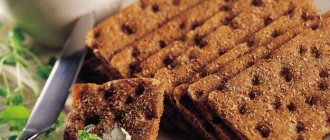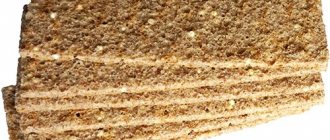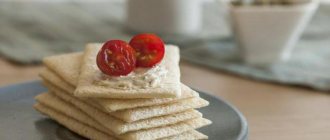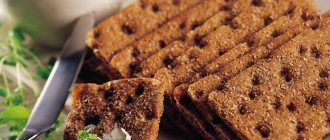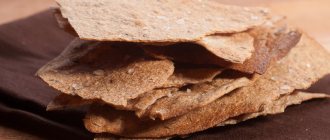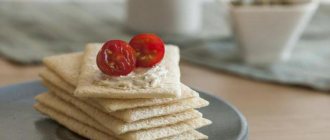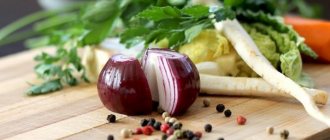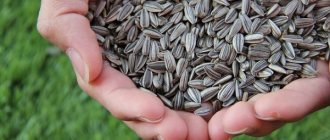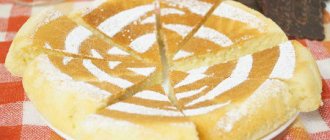Article on the topic
Crispbread is a dietary product. Is it true?
If you want to always stay healthy and slim, stop eating white loaves and rolls made from premium flour and switch to bread products richer in fiber, vitamins and microelements: whole grain loaves, with bran and crispbread. The latter should not be consumed only by children under 2-3 years of age (their young bodies are not yet adapted to such coarse food), but adults can easily make sandwiches from them with low-fat cottage cheese, cheese and vegetables, put low-calorie pates on dry slices and create light ones from them. desserts with fruit. Just don’t think that all bread is equally healthy. There are wonderful crisps made only from whole grains of wheat or corn, and there are examples that do not differ in composition from white bread, and are even supplied with a fair amount of artificial food additives.
Who blew up the wheat?
Whole grain breads made in a machine called an “extruder” are considered the healthiest. They are easy to recognize by their appearance: they look like briquettes (usually round), consisting of swollen grains tightly stuck together. The manufacturing technology of such a product is such that the manufacturer simply cannot put anything harmful to your figure into it: neither fat, nor starch, nor yeast, nor sugar, nor preservatives with dyes. Extruded bread contains only grains and cereals: wheat, rice, buckwheat, corn, pearl barley (unfortunately, they cannot be made from rye). First, the grain mixture is prepared, then it is soaked for half an hour to 12 hours (corn swells for almost a day) so that the rough shells soften a little. Then the grains are poured into the extruder and kept there for 8 seconds at very high pressure and temperature from + 260º C to + 300º C. Under such conditions, the water trapped under the shell instantly turns into steam, and it turns the grain out. In essence, what we get is popcorn, which is familiar to us, but since the grains are in a limited space and have nowhere to grow, after the “explosion” they stick together and form a dense briquette. By the way, these are the breads that are most popular in Europe. Firstly, they have an ideal composition (only wheat, buckwheat, corn, etc.), and secondly, during an incredibly short baking period, the beneficial substances of grains and cereals are preserved in maximum quantities.
Recommendations for use
Best materials of the month
- Coronaviruses: SARS-CoV-2 (COVID-19)
- Antibiotics for the prevention and treatment of COVID-19: how effective are they?
- The most common "office" diseases
- Does vodka kill coronavirus?
- How to stay alive on our roads?
When adding this product to your diet, it is important to monitor the quantity (the daily intake should not exceed 200 grams), as well as the consumption of water, since the product is dry, and therefore the body additionally needs water. The daily recommended amount of water is from 1.5 to 2 liters.
Bread, but dry
If the bread you have chosen does not consist of clearly visible whole grains, but is crispy thin croutons, then they are a baked product and are prepared in the same way as regular bread. First, the dough is kneaded from flour, water, yeast, milk powder and spices, then it is infused, then rolled out into layers and baked. The technology and composition of the ingredients of baked bread allows you to put anything in them, so you should be very careful when choosing this type of product. Let’s say, if the manufacturer used premium flour devoid of vitamins and fiber, did not spare yeast for fluffiness, fat, sugar, salt, antioxidants coded “E” and preservatives for greater preservation, such crisps cannot be called healthy, they will give you unnecessary fast carbohydrates and will differ from a white loaf only in less moisture.
To avoid accidentally purchasing harmful ones instead of super-healthy baked breads, be sure to read their ingredients on the label. Ideal dietary specimens should be made from whole grain or wholemeal flour, without yeast (only baking soda is possible), preferably with the addition of seeds (flax, sunflower, sesame) and, of course, without the presence of modified starch, preservatives, dyes, antioxidants and other additives. Proper bread can only be natural, otherwise they cannot be classified as healthy products.
The benefits of bread: are they all healthy?
The benefits of bread for the human body are obvious. First of all, this is due to their high fiber content, which plays a huge role in the intestinal microflora and in cleansing the body of waste and toxins. In terms of fiber content, only 100 g of bread can replace a kilogram of oatmeal! Therefore, bread is simply irreplaceable for those who want to lose weight.
In addition, whole grain bread is a dietary product that is suitable for absolutely all groups of people.
They are shown to people:
- those who want to lose weight;
- those suffering from allergies;
- having problems with the gastrointestinal tract;
- with metabolic disorders;
- just leading a healthy lifestyle.
Crispbread helps prevent many diseases:
- wheat ones are suitable for gastrointestinal diseases;
- Buckwheat is indicated for anemia - they perfectly increase hemoglobin;
- barley works well for problems with the gastrointestinal tract and liver;
- Oatmeal is recommended for consumption by those who suffer from frequent colds, kidney disease and dermatitis;
- rice will help with diseases of the central nervous system, they are also suitable for people with problem skin.
Multigrain breads also perform well and are suitable for absolutely everyone.
The product contains the following components beneficial to the body:
| Name | Benefit |
| Dietary fiber and cellulose | They satisfy hunger, preventing overeating, reduce cholesterol, remove toxins from the body, improve digestion, and make bowel movements regular. |
| Unsaturated fatty acids | They normalize blood pressure, prevent heart disease, reduce the risk of developing cancer, strengthen the nervous system and immunity. |
| Essential amino acids | Participate in the formation of tissues, cells, enzymes, hormones, antibodies. |
| Vitamins | The antioxidants contained in the bread prevent premature aging and improve immunity, and vitamins PP and B affect the functioning of the central nervous system. |
| Microelements | Crisp bread contains a full range of microelements necessary for the normal functioning of the brain, bones, blood, blood vessels, and immune system. |
And lastly, unlike baked goods, bread does not contain yeast, which is also important for the body, especially for those people who watch their figure.
Brittle and crunchy
Some people like Borodino bread with coriander, others prefer rye bread with dill, and still others choose whole grain “exploded” ones. Fortunately, the range of healthy snacks today is huge. But no matter what type of crisps you choose, pay attention to their quality. According to technologists, ideal breads cannot be soft, moist or, conversely, too “woody” (otherwise they will pose a threat to the integrity of the teeth). They should be dry, brittle, crispy, well cooked and easy to bite. The edges of the correct specimens are smooth, not crumbling, the color is uniform: it’s bad when it’s light in one place and dark brown in another. The surface of baked bread may be rough, and “exploded” ones may have small voids due to the proximity of grains of different diameters, but there should not be too many of them.
Beneficial features
Regular consumption of wafer bread helps our digestive system cope with its task, and also facilitates the passage of food through the intestines. Bread is recommended to replace bread for people suffering from stomach and duodenal ulcers. Wafer breads are often recommended for use by people suffering from gastritis or intestinal atony.
The composition, which excludes the presence of any yeast, suggests that wafer breads are useful for both therapeutic nutrition and weight loss.
Packaging defects
When choosing bread rolls, pay attention to the integrity of the packaging they are in: the box should not be wrinkled, the bag should not be torn. If there is a defect, it means that the product could become damp and moldy or, conversely, dry out. Of course, it’s not for nothing that bread got the nickname “canned bread” - they have a very long shelf life, but they can also go bad. Briquettes made from “exploded” grains are stored the longest. They contain a minimum of moisture and fat (only natural fat, contained in seeds and cereals), they do not go rancid and “live” up to 18 months. Baked goods contain vegetable oil, flour and additives, so they have a shorter shelf life of 6-10 months.
Why are they harmful, are there any contraindications?
In matters of the benefit of a product or possible harm, everything depends on the technology of its manufacture.
Products made not from grain, but from flour, are more harmful than beneficial, especially considering the fact that yeast, dyes, flavor enhancers, and other additives are often added to them.
They are prepared almost the same as regular bread, only the shape changes.
Any bread can provoke an allergic reaction.
And even healthy products should not be given to children under three years of age , since their body may not yet be able to digest coarse fiber.
Expert opinion
Alexandra Romanova, leading innovation specialist for the Healthy Nutrition product line of Khlebprom OJSC The calorie content of bread is about 300 kcal. This is almost the same as bread, because these products are made from the same raw materials - grain, which has a certain energy content. True, bread rolls are carriers of “long-lasting” carbohydrates - they are easily absorbed by the body and at the same time give a feeling of fullness. In addition, they are rich in fiber. And it interferes with the absorption of calories. That is, by consuming 35 g of fiber per day, you burn 245 kcal. If you want to lose weight, eat no more than 3-5 breads and combine them with low-fat cottage cheese, cheese, herbs, vegetables and berries.
Calorie content Wheat bread, whole grain. Chemical composition and nutritional value.
Nutritional value and chemical composition of “Wheat bread, whole grain”.
The table shows the nutritional content (calories, proteins, fats, carbohydrates, vitamins and minerals) per 100 grams of edible portion.
| Nutrient | Quantity | Norm** | % of the norm in 100 g | % of the norm in 100 kcal | 100% normal |
| Calorie content | 285 kcal | 1684 kcal | 16.9% | 5.9% | 591 g |
| Squirrels | 11.8 g | 76 g | 15.5% | 5.4% | 644 g |
| Fats | 2.1 g | 56 g | 3.8% | 1.3% | 2667 g |
| Carbohydrates | 55 g | 219 g | 25.1% | 8.8% | 398 g |
| Organic acids | 0.3 g | ~ | |||
| Alimentary fiber | 7.5 g | 20 g | 37.5% | 13.2% | 267 g |
| Water | 33.3 g | 2273 g | 1.5% | 0.5% | 6826 g |
| Ash | 1.8 g | ~ | |||
| Vitamins | |||||
| Vitamin A, RE | 9 mcg | 900 mcg | 1% | 0.4% | 10000 g |
| Retinol | 0.008 mg | ~ | |||
| beta carotene | 0.008 mg | 5 mg | 0.2% | 0.1% | 62500 g |
| Vitamin B1, thiamine | 0.16 mg | 1.5 mg | 10.7% | 3.8% | 938 g |
| Vitamin B2, riboflavin | 0.05 mg | 1.8 mg | 2.8% | 1% | 3600 g |
| Vitamin B5, pantothenic | 0.58 mg | 5 mg | 11.6% | 4.1% | 862 g |
| Vitamin B6, pyridoxine | 0.17 mg | 2 mg | 8.5% | 3% | 1176 g |
| Vitamin B9, folates | 23 mcg | 400 mcg | 5.8% | 2% | 1739 |
| Vitamin E, alpha tocopherol, TE | 1.7 mg | 15 mg | 11.3% | 4% | 882 g |
| Vitamin RR, NE | 4.7 mg | 20 mg | 23.5% | 8.2% | 426 g |
| Niacin | 3.3 mg | ~ | |||
| Macronutrients | |||||
| Potassium, K | 225 mg | 2500 mg | 9% | 3.2% | 1111 g |
| Calcium, Ca | 34 mg | 1000 mg | 3.4% | 1.2% | 2941 g |
| Silicon, Si | 6 mg | 30 mg | 20% | 7% | 500 g |
| Magnesium, Mg | 63 mg | 400 mg | 15.8% | 5.5% | 635 g |
| Sodium, Na | 343 mg | 1300 mg | 26.4% | 9.3% | 379 g |
| Sera, S | 75 mg | 1000 mg | 7.5% | 2.6% | 1333 g |
| Phosphorus, P | 172 mg | 800 mg | 21.5% | 7.5% | 465 g |
| Chlorine, Cl | 21 mg | 2300 mg | 0.9% | 0.3% | 10952 g |
| Microelements | |||||
| Aluminium, Al | 570 mcg | ~ | |||
| Bor, B | 48 mcg | ~ | |||
| Vanadium, V | 103 mcg | ~ | |||
| Iron, Fe | 2.8 mg | 18 mg | 15.6% | 5.5% | 643 g |
| Cobalt, Co | 2.5 mcg | 10 mcg | 25% | 8.8% | 400 g |
| Manganese, Mn | 0.44 mg | 2 mg | 22% | 7.7% | 455 g |
| Copper, Cu | 70 mcg | 1000 mcg | 7% | 2.5% | 1429 g |
| Molybdenum, Mo | 11.3 mcg | 70 mcg | 16.1% | 5.6% | 619 g |
| Nickel, Ni | 11.5 mcg | ~ | |||
| Tin, Sn | 3.2 mcg | ~ | |||
| Titanium, Ti | 8.9 mcg | ~ | |||
| Fluorine, F | 20 mcg | 4000 mcg | 0.5% | 0.2% | 20000 g |
| Chromium, Cr | 1 mcg | 50 mcg | 2% | 0.7% | 5000 g |
| Zinc, Zn | 0.59 mg | 12 mg | 4.9% | 1.7% | 2034 |
| Digestible carbohydrates | |||||
| Starch and dextrins | 54 g | ~ | |||
| Mono- and disaccharides (sugars) | 1 g | max 100 g | |||
| Sucrose | 1 g | ~ | |||
| Essential amino acids | 4.393 g | ~ | |||
| Arginine* | 0.5405 g | ~ | |||
| Valin | 0.5635 g | ~ | |||
| Histidine* | 0.2415 g | ~ | |||
| Isoleucine | 0.5175 g | ~ | |||
| Leucine | 0.9315 g | ~ | |||
| Lysine | 0.299 g | ~ | |||
| Methionine | 0.184 g | ~ | |||
| Threonine | 0.368 g | ~ | |||
| Tryptophan | 0.1265 g | ~ | |||
| Phenylalanine | 0.621 g | ~ | |||
| Nonessential amino acids | 7.3025 g | ~ | |||
| Alanin | 0.391 g | ~ | |||
| Aspartic acid | 0.437 g | ~ | |||
| Glycine | 0.4255 g | ~ | |||
| Glutamic acid | 3.68 g | ~ | |||
| Proline | 1.196 g | ~ | |||
| Serin | 0.6095 g | ~ | |||
| Tyrosine | 0.3105 g | ~ | |||
| Cysteine | 0.253 g | ~ | |||
| Sterols (sterols) | |||||
| Cholesterol | 4 mg | max 300 mg | |||
| Saturated fatty acids | |||||
| Saturated fatty acids | 0.4 g | max 18.7 g | |||
| 14:0 Miristinovaya | 0.0044 g | ~ | |||
| 16:0 Palmitinaya | 0.2878 g | ~ | |||
| 18:0 Stearic | 0.0374 g | ~ | |||
| Monounsaturated fatty acids | 0.2726 g | min 16.8 g | 1.6% | 0.6% | |
| 18:1 Oleic (omega-9) | 0.2726 g | ~ | |||
| Polyunsaturated fatty acids | 0.9619 g | from 11.2 to 20.6 g | 8.6% | 3% | |
| 18:2 Linolevaya | 0.879 g | ~ | |||
| 18:3 Linolenic | 0.0828 g | ~ | |||
| Omega-3 fatty acids | 0.1 g | from 0.9 to 3.7 g | 11.1% | 3.9% | |
| Omega-6 fatty acids | 0.9 g | from 4.7 to 16.8 g | 19.1% | 6.7% |
The energy value of whole grain wheat bread is 285 kcal.
Primary Source: Created in the application by the user. Read more.
** This table shows the average levels of vitamins and minerals for an adult. If you want to know the norms taking into account your gender, age and other factors, then use the “My Healthy Diet” application.
Application
Before you buy such a loaf of bread in a store, carefully study its composition - this will determine what type of loaf of bread you should choose. In addition to the composition, it is worth looking at the uniformity of consistency and uniformity of color. The product should be baked evenly on all sides, not crumble when cut, and be crispy when bitten.
To ensure that your diet is truly balanced, it is advisable to consult a nutritionist before switching to this type of product. Doctors usually recommend starting to introduce bread gradually. First, use them once a day, and then completely replace regular bread with them.
The crispbreads are delicious on their own and are also great for making toast, sandwiches, sandwiches, and even sweet tartines.
Market Analytics
- Global cosmetics market 2021: an unprecedented test for the global cosmetics industry
- Top 10 Cosmetic Research and Development of 2021
- 2020 in the beauty industry – innovation without borders
Convenient search for beauty salons on our website
Beauty salons in Moscow Beauty salons in St. Petersburg Beauty salons in Ekaterinburg Beauty salons in Novosibirsk
Latest blog posts on our website
- Naturecream / Properties of the “Sunny” oil itself
- Naturecream / “Sugar” wrinkles - or what glycation can do
- Naturecream / Esterified oils
- Naturecream / Arnica - the magical plant of alchemists
- Naturecream / Tremella Extract - Snow Mushroom Detox for Skin
- Prostye-sovety / How to visually enlarge your lips with makeup
- Naturecream / Apricot kernel oil for face
- Naturecream / MATRIXYL3000 - the best skin elasticity stimulator
- Naturecream / SPF in Natural Oils
- Naturecream / Geranium (Pelargonium) oil for skin health and beauty
Latest forum topics on our website
- Natalya / How to properly make a gelatin mask?
- Mrs._Smith / Badly sunburned! What to do?((
- Ice / Is it necessary to combine fitness classes with a diet?
- Antonova / What can be used for hair loss?
- Radio operatorKat / Who was on a protein diet?
Other articles in this section
| Buckwheat Bread Nowadays, for those who watch their diet, the question constantly arises about which bread is the most healthy. The range of products is so large and varied that it can be difficult to decide. For overweight people, buckwheat bread is considered the most suitable. Its calorie content is 228 Kcal per 100 g. |
| Bagel The bagel originates from Poland, from Krakow, where its recipe was invented in the 17th century. It is bread baked from yeast dough in the shape of a palm-sized ring, covered with a crispy crust, and sometimes sprinkled with poppy seeds, sesame seeds or rubbed with garlic. |
| English grain bread Grain bread differs from ordinary bread not only in composition, but also in the method of preparation. In order to bake English grain bread, first of all, you need to have the following products: wheat grain, water, yeast, flour, butter, salt. You can change the composition to your taste, add honey, milk or other ingredients to the recipe. |
| Mustard Bread The origin of bread began in the Neolithic. At the very beginning of its existence, bread looked like baked mush, but over time, various spices began to be added to it, including mustard. |
| Garlic bread Bread is the head of everything. This saying carries great semantic meaning, because this product has more than once saved people from starvation. Today, bread and bakery products remain the most important products of humanity. |
| Banana bread Delicious banana bread is known all over the world. It is called "banana bread". This product is a kind of “mix” of bread and cake. But the recipe belongs to the first category. |
| Malt bread Bread is one of the oldest products of mankind. Despite this fact, it continues to be the most important product in our lives. In many countries, bread and baked goods are very popular. |
| Pita The Middle East reveres pita as bread, which should always be present on the table. An ordinary unleavened flatbread can also serve as a delicacy, or can be used as a basis for preparing fast food. |
| Wheat bread Wheat, as a cereal crop, has been grown for thousands of years. Nowadays, it is necessarily cultivated in most countries of the world. The wheat product of greatest importance is flour, which is used to make various types of bread and sweet pastries, depending on the degree of grinding. |
| Old Russian grain bread In Rus', bread has always been the center of everything. This meant that bread was a sign of hospitality, friendship and peace in the home. |

